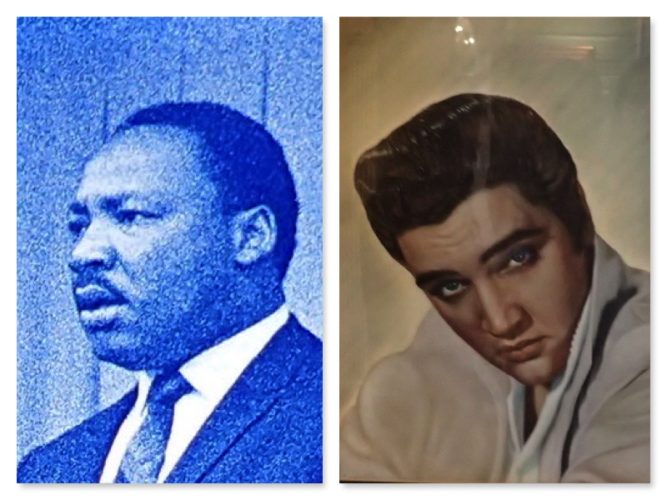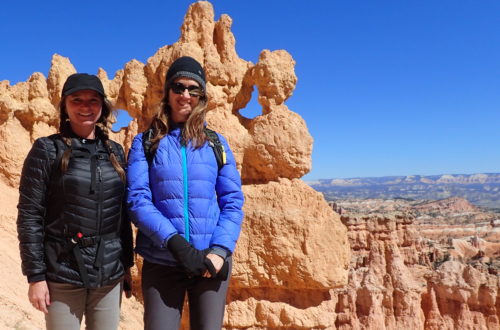
Death in Memphis
Abby (the Hound Dog) and I are on our own again, headed to Memphis. I think Bill Bryson best described driving alone for an extended period of time in his book The Lost Continent: Travels in Small-Town America.
“On a road as straight and as wide as an American Interstate, fifty-five miles an hour is just too slow. It feels like walking speed. Cars and trucks coming towards you in the opposite direction seem to be traveling on one of those pedestrian conveyor belts you find in airports. You can see the people inside, get a long, lingering glimpse into their lives, as they slide past.
And there’s no sense of driving. You need to put a hand to the wheel occasionally just to confirm your course, but you can take the time out to do the most intricate things- count your money, brush your hair, tidy up the car, read maps and guidebooks, put on or discard articles of clothing. If your car possessed cruise control, you could just about climb in the back and take a nap. It is certainly quite easy to forget that you are in charge of two tons of speeding metal, and it is only when you start to scatter emergency cones at roadwork sites or a truck honks at you and you realize that henceforth you probably shouldn’t leave your seat to search for snack food.”
There is something glorious about solo, cross-country driving. My mind searches out those things that I pushed aside and hid away, then shines a blinding light on them and says “Let’s think about this NOW.” It is therapeutic, closer to a cleansing ritual or a religious experience. As the lyrics of My Church by Maren Morris state “I find holy redemption when I put this car in drive, roll the windows down and turn up the dial. Can I get a hallelujah? Can I get an amen?”
Memphis is different. It has much less traffic. With a very vintage vibe, it is full of music history. Downtown sprawls in one direction and stops at the bank the Mississippi River in another. (During our visit, my mind is permanently stuck on chanting “M-I-S-S-I-S-S-I-P-P-I”.) We stay in the garden district, full of lovely tree-friendly and flower-lined streets with stately homes. Abby and I enjoy our Memphis morning walks immensely for the diverse visual interest.
Memphis’ best known attractions are Beale Street and Graceland, both intimately associated with the city’s place in American music history of the blues, rockabilly, and rock-n-roll. Beale Street is a national historical landmark and shows the impact Memphis had on American blues. Famed African-American composer W.C. Handy wrote the first commercially successful blues song “St. Louis Blues” in a bar on Beale Street in 1912. Many renowned musicians grew up in Memphis and then moved to other cities, carrying their influence to other places. These included such musical greats as Elvis Presley, Jerry Lee Lewis, Muddy Waters, W. C. Handy, Johnny Cash, B.B. King, Booker T. Jones, Al Green, Justin Timberlake, and Aretha Franklin.
I wasn’t a fan of Elvis and I didn’t like his music. Searching my music collection, I uncover only two Elvis songs, Crazy Little Thing Called Love and You’re So Square, Baby I Don’t Care, from an old boyfriend’s forgotten playlist. However, Graceland fascinates me. I am eager to tour the house and learn more about the legend.
There is an entire culture around Elvis Presley. It seems people have either a hunk a hunk burning love for Elvis or you would like to return to sender. He isn’t mild enough for people to be neutral. The house reflects that completely. It is one of the most visited houses in the United States, second only to the White House. In the Visitor Center, there is a path winding through the tacky gift store, then passed the photograph-taken-for-later-purchase station, and finally, the shuttle bus to the house. I am issued headphones along with an iPad loaded with a tour of the house.
The house is moderate by today’s standards. As you enter the house, the foyer sits directly beneath the master bath where Elvis died from cardiac arrest. You can’t tour the second floor, as Elvis never allowed anyone upstairs, except for the house’s residents. They respected his feelings after his passing. John Stamos’ voice (of General Hospital and Full House fame) explains this in my ears while I follow along with the iPad tour.
Graceland has one bedroom downstairs for Elvis’ parents, a fancy living room, the Jungle room (which was lined in carpet and where Elvis occasionally recorded), a kitchen, a dining room, a basement pool room, and a basement media room. It has additional buildings in the back that held offices for the business of all things Elvis and a racquetball court.
Mr. Stamos, purring in my headphones, does an excellent job of humanizing Elvis, describing his emotions for Priscilla and the more (love me) tender side of him. He talks about how Elvis had a stillborn twin. How his daughter, Lisa Marie sometimes still has Thanksgiving dinner at Graceland. How Elvis’ mom would use the kitchen to make him peanut butter and banana sandwiches. How his dad managed the business, didn’t tolerate loitering in his office, and expected a little less conversation. How Elvis was so generous to his friends and family. How he chose to serve in the Army in a regular unit, rather than the cushier Special Services where he could have performed his music.
John also tells the story of how Elvis died at the age of 42 after entertaining some of his friends in the racquetball lounge. At the end of the tour, when you walk past Elvis’ grave, the story evokes the grief and sorrow that is appropriate at a grave site of a human who tried his best to help others. There are more than a few tears in my group.
There is much controversy about the cause of Presley’s death, but what is clear is that he died an opioid addict. In the eight months before his death, his doctor prescribed at least 8,805 pills and sundry forms of drugs that included Dilaudid, Quaalude, Percodan, Demerol and cocaine hydrochloride. To reconstruct the prescription record, investigators had to contact 153 pharmacies.
I would like to remember Elvis for the man that he tried to be. In the words of the song he wrote for his mother’s funeral, Elvis was That Someone You Never Forget.
During the 1960s, Memphis was the center of the Civil Rights Movement, as its large African-American population was affected by state segregation practices and disenfranchisement. February 1968 marked the gruesome deaths of two workers in a garbage-compacting truck sparking the Memphis sanitation strike. The workers, who were overwhelmingly African-American, demanded living wages and better working conditions. Black workers were paid significantly lower salaries then white workers. There were no uniforms, restrooms, unions, or grievance procedures. They marched to gain public awareness and support for their plight. The work was dangerous, and the pay was low. The city government resisted their plea for a better work situation.
On April 4, Rev. Martin Luther King, Jr., known for his leadership in the non-violent movement, came to Memphis to lend his support to the workers’ cause. As usual, he stayed at the Lorraine Motel in Room 306. In the room, King spoke to musician Ben Branch, who was scheduled to perform that night at a planned event. King said, “Ben, make sure you play ‘Take My Hand, Precious Lord’ in the meeting tonight. Play it real pretty.”
King walked onto the balcony and was struck in the face by a single bullet fired from a rifle. The bullet entered through King’s right cheek, traveled down his spinal cord, and lodged in his shoulder. MLK fell backward onto the balcony, unconscious but with a pulse. King was rushed to the hospital, where doctors opened his chest and performed CPR. He never regained consciousness and died at 7:05 pm.
The day before his death, King gave his prophetic I’ve Been to the Mountaintop speech. “We’ve got some difficult days ahead. But it doesn’t matter with me now. Because I’ve been to the mountaintop. And I don’t mind. Like anybody, I would like to live a long life. Longevity has its place. But I’m not concerned about that now. I just want to do God’s will. And He’s allowed me to go up to the mountain. And I’ve looked over. And I’ve seen the promised land. I may not get there with you. But I want you to know tonight, that we, as a people, will get to the promised land! And so I’m happy, tonight. I’m not worried about anything. I’m not fearing any man. My eyes have seen the glory of the coming of the Lord!”
Grief-stricken and enraged after learning of King’s murder, many African Americans in Memphis rioted, looting businesses and other facilities. The governor ordered Tennessee National Guardsmen into the city within hours.
Witnesses saw a white man, believed to be James Earl Ray, fleeing from a rooming house across the street from the Lorraine Motel. Police found a package dumped close to the site, which included a rifle and binoculars, both with Ray’s fingerprints. A worldwide manhunt culminated in his arrest in London two months later. James Earl Ray pled guilty to the murder and was sentenced to 99 years in prison.
The National Civil Rights Museum includes both the building where King was assassinated and the building where the shooter aimed and fired. It covers all aspects of the movement. Two most notable displays are the model of the bus on which Rosa Parks rode and the exhibit of the Freedom Rides of 1961. The words of MLK’s final speech are immortalized in iron on the gates of the museum.
The sites of the deaths of Elvis and Martin Luther King leave me empty, disheartened, and somber. I can’t shake this emotional gloominess. For the first time on this trip, I long to have my familiar support circle around me.
Right on time, I am ready to return home.


You May Also Like

Lessons Learned, Part Two
January 13, 2018
The Best of Colorado, Utah and Arizona
January 16, 2018
